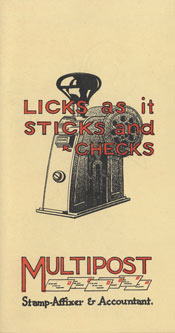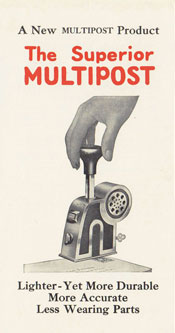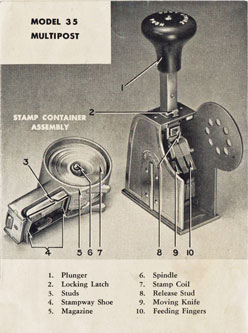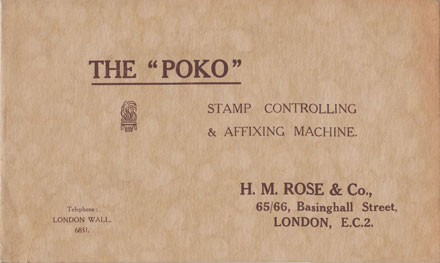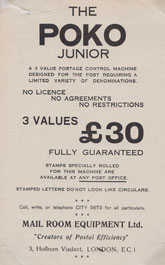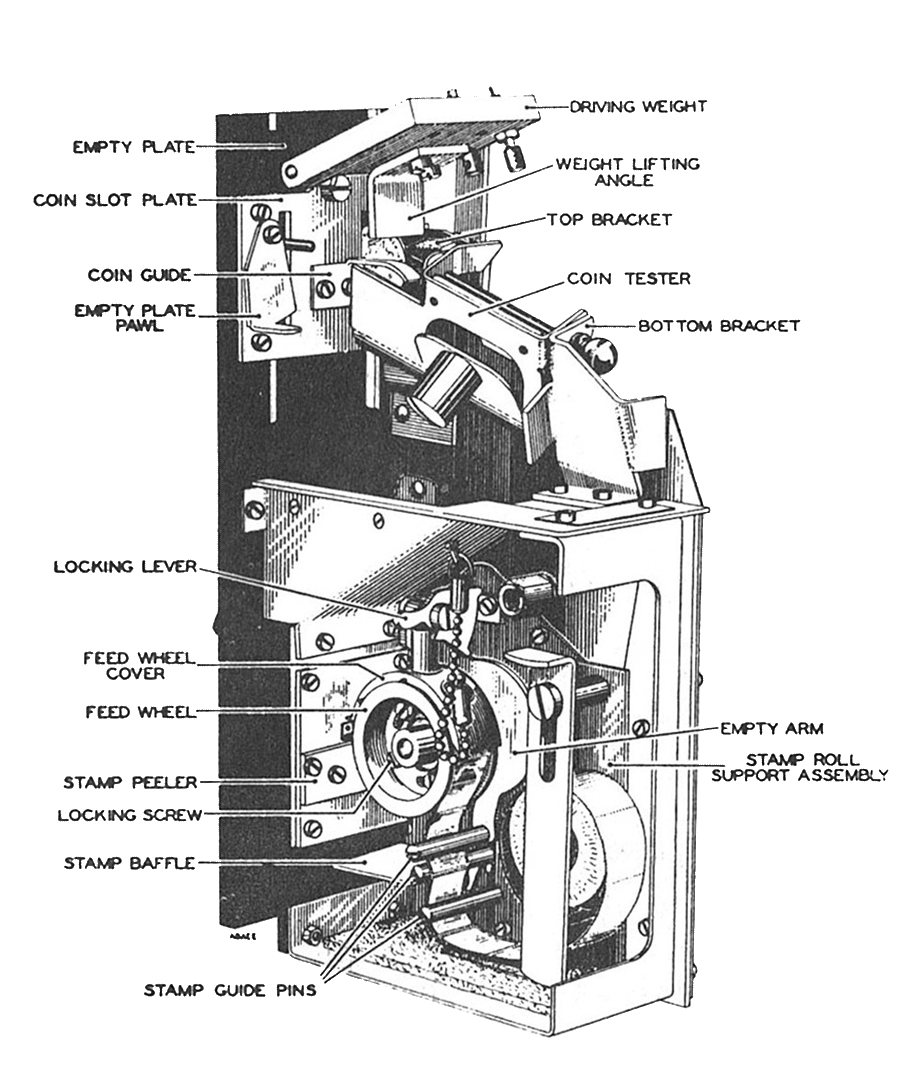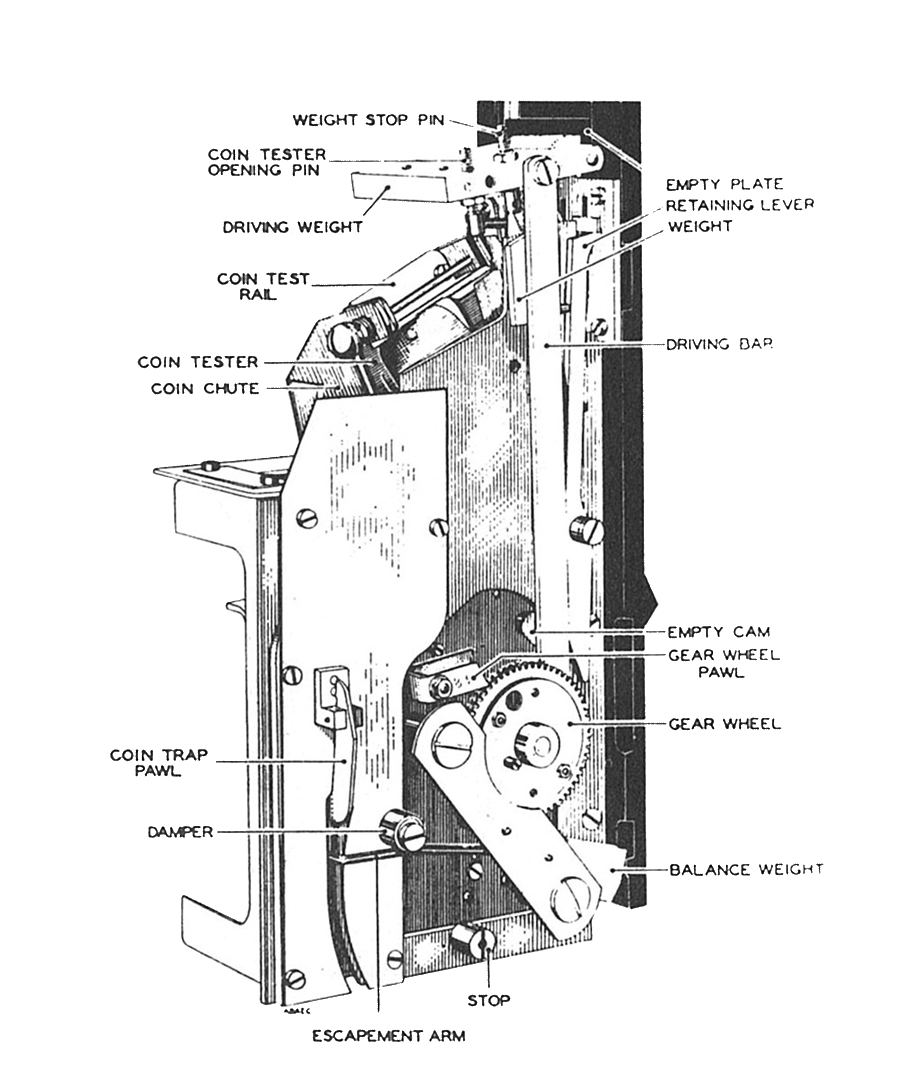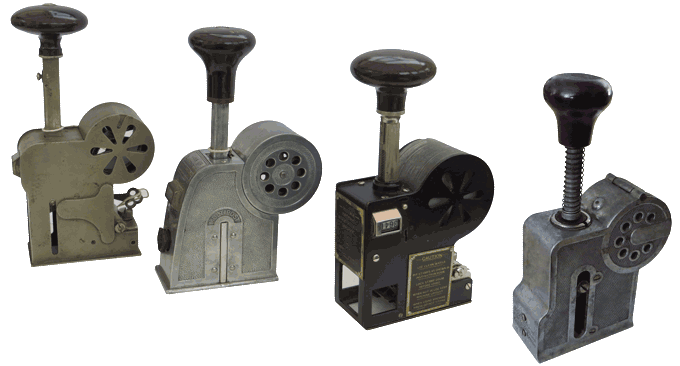
Handheld affixers: Fixo, Multipost, National, Standard.
Each had many patents, yet the designs look remarkably similar.
Although this website is about GB Stamp Rolls, the affixing and vending machines that used rolls were international, many made in the United States with marketing agents around the world. Those machines that are known to have been sold in the UK are noted, but it is quite likely that others, especially handheld affixers, made it to the UK. Hence, this page describes those that made it into production. It is, however, extremely unlikely that a UK stamp will be found with Schermack perforations.
Handheld Affixers
The first patent for a stamp affixer in the US was granted to George K Snow of Watertown, Massachusetts on 18 May 1858 (US patent 20306). The first patent for a stamp affixer in the UK was granted to Victoria Isabella Heliodora Bundsen of London, England on 19 Apr 1884 (UK patent 6568) and in the US on 21 July 1885 (US patent 322578). Over the next 20 years there were patent applications for more than 100 different stamp affixers, but it was not until around 1910 that commercially successful models became available.
In the US, handheld affixers were developed primarily around the New York and Boston areas with Multipost, Simplex, and Standard taking the early lead, and Multipost becoming the long-term winner. Of the various mechanical designs, the market coalesced on a design with four main components: a circular compartment to hold a roll of stamps; a plunger to press a stamp onto an envelope; a water tank to wet the gum; and a knife edge to separate the stamp from the roll. Although some affixers used endways delivery rolls, sideways delivery became the preferred method, and before official rolls were available (1908 in the US, 1912 in the UK) the machine manufactures made up their own rolls from sheet stamps. The main competition to affixers was metered mail but many large mailers preferred a stamp believing that the recipient was more likely to open an envelope with a real stamp than one with a meter mark.
Of the handheld affixers sold in the UK (Fixo, Lightning, Multipost, National, Postmaster, Standard), Fixo dominated during the 1910s, then Multipost from the 1920s (after the introduction of sideways rolls), and Postmaster/Bandafix from the 1950s.
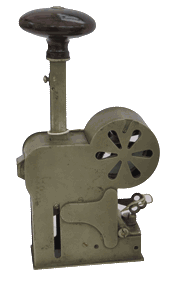
FIXO
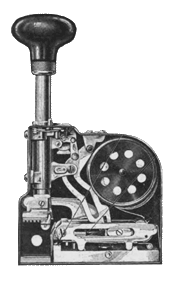
Kendall
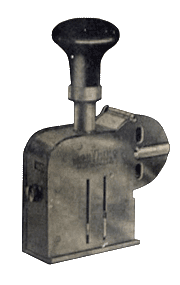
Lightning
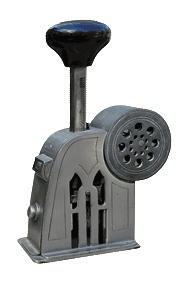
Multipost Model T
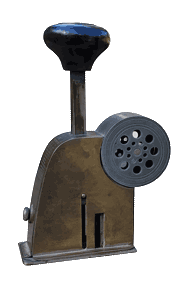
Multipost Model X
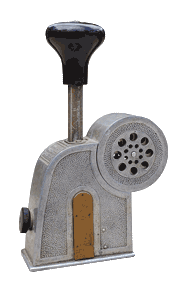
Multipost Model 20
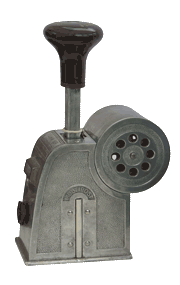
Multipost Model 35
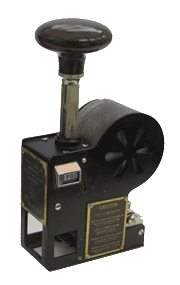
National
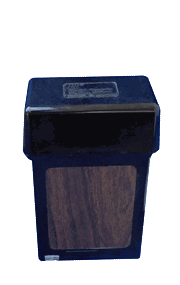
Postafix
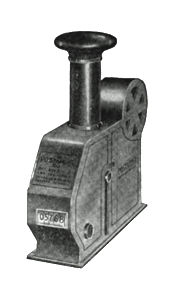
Postamper 1
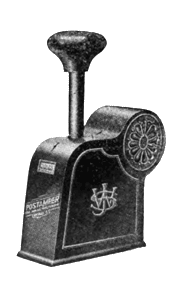
Postamper 2
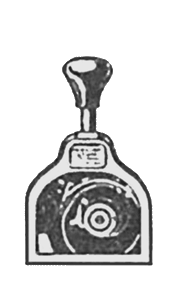
Postcraft
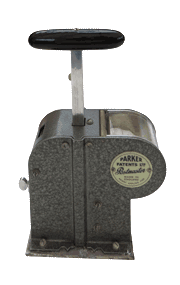
Postmaster
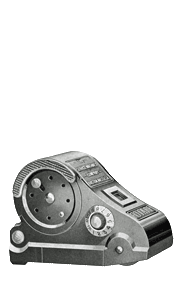
RO-TA-RE
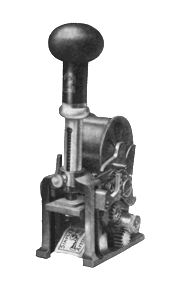
Simplex 1
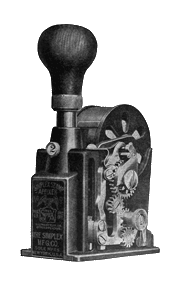
Simplex 2
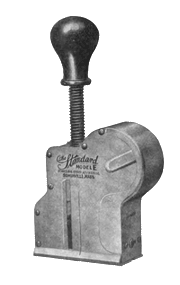
Standard Model E
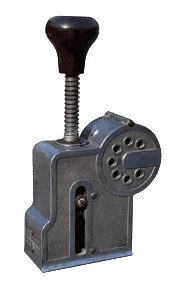
Standard 2
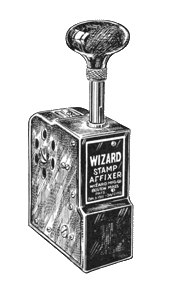
Wizard
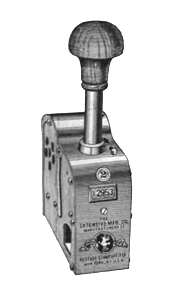
World Wide
UK Handhelds
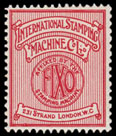
FIXO (London): was the most popular early affixer in the UK but later lost share to Multipost. The body of the affixer was brass, rather than the steel bodies used by other early affixers. The International Stamping Machine Co Ltd was formed on 1 Nov 1910 and purchased several patents which had been filed from 1907 onward by Percy G E Daniel and Charles A H Bullock, the first of which was filed in the UK 13328/07, followed by one in the US 957658. The company was at 231 Strand, London WC, then moved c.1915 to 59-61 New Oxford St, London W. Four patents were listed on the affixer body: 13328/07, 12476/07, 4614/11, and 9246/11. The affixer used top end delivery rolls made up by the company from sheet stamps, but from August 1912 could use Post Office rolls ½d(E) and 1d(G), and later 1½d(L) and 2d(R). An article in The Efficiency Magazine (April 1913) said: it is anticipated that the “Fixo” will be introduced in the United States within the next two months, but that didn’t seem to happen and, despite initial success, the company closed down in May 1916 and its patents were acquired by the New International Stamping Machine Co (see National below).
Lightning (London): a later affixer c.1933 which used sideways rolls. UK patent 414194 was filed in 1933 by Frank Pitchford of 11 Well Street, London EC1 and Hall Telephone Accessories (1928) Ltd of 70 Dudden Hill Lane, London NW10. The Lightning did well in New Zealand where rolls were made specifically for it from about 1935 to 1970. These rolls had half-inch cores instead of three-quarter inch and had “LIGHTNING ROLL” printed on the leaders. At some point, the affixer was part of the “Velos Lightning” product line (lightning affixer, lightning perforator, lightning numbering machine, etc).
National (London): another UK affixer c.1917 which used the same top end delivery rolls as FIXO: (E), (G), (L), and (R). The New International Stamping Machine Co Ltd was at 123 Queen Victoria St, London EC4. The name plate on the affixer listed three patents acquired from FIXO (as International Stamping Machine Co Ltd): 9246/11, 4524/13, 1290/13, and one patent under the new company name 115074. An additional patent 156040 was filed in 1920. A 1921 advert lists the National available from Edison Swan Electric Co Ltd at 123 Queen Victoria St (the same address as above). The New International Stamping Machine Co Ltd closed its doors in 1926 apparently without much success.
Stamp-A-Fix/Bandafix/Postmaster (London): a “modern” affixer c.1958 marketed by Block & Anderson Ltd, 58-60 Kensington Church St, London W8. Originally called Stamp-A-Fix but rebranded as Bandafix to be part of their “Banda” product line. Sold as a Made-in-England alternative when sales of Multipost were discontinued in the UK due to import restrictions. Later sold by Parker Patents Ltd as the Postmaster.
US Handhelds
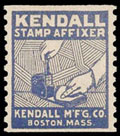
Hall/Puritan/Peerless/Wizard/Kendall (Boston, MA): are the same affixer with different name plates. The initial company Puritan Mailing Machine Co (incorporated 1912, dissolved 1915) located at 301 Congress Street, Boston marketed the affixer in 1912 as the Hall Stamp Affixer (Alfred Hall held the patents), in 1913 as Puritan, and 1914 as Peerless. After this company was dissolved, the affixer was marketed in 1915 by the Wizard Co (incorporated 18 Jan 1915), 179 Summer St, Boston, and in 1917 by the Kendall Manufacturing Co (Alfred Hall president, incorporated 10 Oct 1917), 79 Sudbury St, Boston. Alfred Hall and Miss Kendall attended the New York Business Show at the 69th Regiment Armory in Oct 1916. None of these incarnations of Hall’s machine were successful. He held patents dated 1912-12-03, 1913-09-02, and 1916-02-15 (US patents 1046292, 1071912, 1171786) which were sold to the Bircher Company of Rochester, New York circa 1920.
Postamper (Chicago, IL): c.1913, incorporated in 1914 by James W Small, Elmer S Butterson, Joseph N Small. In 1914 and 1915 two Chicago address were used: 39 So. La Salle Street and 325 New York Life Building. By 1918 the affixer looked much more like a Multipost (pictured as “Postamper 2” above) and was manufactured by the International Postal Machinery Co and distributed by Polak Van Almelo Bros (with “Almelo” incorrectly spelled as “Alemlo” in some adverts). A paragraph in Office Appliances (Dec 1916): the Multipost Company has filed suit against Joseph Polak van Almelo who took over the manufacture and sale of the Postamper. The complaints allege that the Postamper infringes upon the Multipost patents.
Postcraft (New York): c.1909 the P R Manufacturing Company of Detroit, Michigan made a stamp vending machine (US patent 1071178), then c.1911 a combined vending and affixing machine (US patents 1076517 and 1274448). In 1914 a new handheld type of affixer was introduced using sideways rolls (US patent 1239624) and a new company formed in New York. According to Advertising & Selling (Jan 1915): the first machine would not “stand up”; a second model was an improvement but also not satisfactory; another model was built and those already sold were taken back and scrapped. In the meantime, a different type of machine was developed, and the name was changed from the C & R Stamp Affixer to the Postcraft. However, the stockholders refused to add more money and the company went bankrupt.
RO-TA-RE (Boston, MA): c.1920 a different shaped affixer, but still handheld — “It fits in the palm of your hand”. There were two models: “A” without a counter, and “AC” with a counter. Made by the Service Machines Company at 79 Sudbury St, Boston (incorporated 11 Oct 1917, one day after and at the same address as the Kendall Manufacturing Co). The affixer was opened with a three-digit combination lock, no key required. Patented by Harry H Daniels (US patent 1346484).
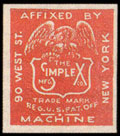
Simplex/World Wide (New York): was the most popular early affixer in the US but later lost share to Multipost and others. It used endways imperforate rolls and was patented by Charles J Fancher and James H Burt (US patents 952439 and 977175). Fancher got the Simplex Company to manufacture the affixer which was distributed by Drummond-Ludlow in 1909 (pictured as “Simplex 1” above). According to Advertising & Selling (Jan 1915): a large force of men was selling the affixer on commission, but the machines did not work and came back almost as rapidly as they had been put out, resulting in Drummond-Ludlow suing Simplex. Simplex improved the affixer and endeavoured to market it themselves in 1910 directly from their headquarters at 90 West St, New York (pictured as “Simplex 2” above), but this resulted in the company folding. Fancher developed another machine c.1911 using sideways rolls called the World Wide Stamp Affixer (US patent 1077954), and manufactured by a reorganized company called the Extensive Manufacturing Co. Although names changed, the new model was made at the same factory in Thompsonville, Connecticut and distributed from the same address at 90 West St, New York. In 1919, the New Writerpress Co of Shelton, Connecticut acquired the manufacturing rights for the Simplex stamp affixer and Simplex envelope sealer.
Standard (Somerville, MA): c.1910 the company made a small desktop affixer patented by Frederick W Storck (US patent 993732). This model was not successful, although a patent for a second version of this affixer was filed a year later (US patent 1211499). In 1912 a more successful handheld model was made using sideways rolls – the “Standard Model E” (US patent 1193730). Models C, F, G, and H were hand operated envelope sealers, Model M was an electric motor driven envelope sealer. Initially the affixer body was steel, then in 1928 the body was redesigned using aluminum alloy (no model number but pictured as “Standard 2” above). The company was in the Boston area at 371 Somerville Ave, Somerville, Mass. Then in August 1919 moved to a new factory building at 1935 Revere Beach Parkway, Everett, Mass. The two-story brick building still stands at this address. After adding a postal permit printer in 1923, the company name was changed from Standard Stamp Affixer Co (incorporated 12 May 1910) and Standard Envelope Sealer Mfg Co (incorporated 27 Oct 1913) to Standard Mailing Machines Co. The affixer was sold in the UK through agents: Roberts Numbering Machine Co, 63 Chancery Lane, London WC2, and later Display Products Co, Faraday House, Charing Cross Rd, London WC2.
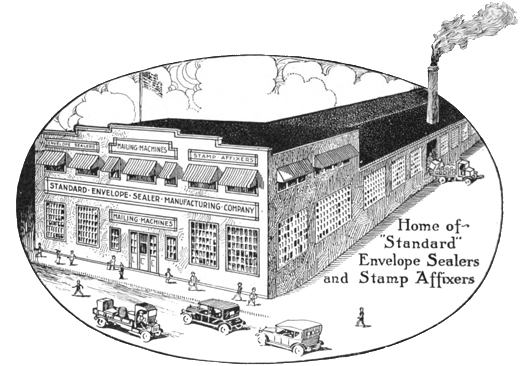
1935 Revere Beach Parkway, Everett
Multipost
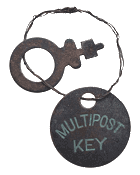
William F Schweiger started the Multipost Company in 1910 after working as general manager at Schermack. Bennett D Straight was the mechanical design engineer, and Edward C Morris provided the capital. A typical high-tech startup of its era! A short piece in the Rochester Democrat and Chronicle on 27 Mar 1927 said: The Multipost Company started its business in Rochester in 1910 in a small room on the second floor of a building at No. 296 State Street. A few years later it became necessary to move into larger quarters, half of the third floor of the building at Allen Street and Plymouth Avenue being acquired. Later the company purchased two lots at Oak Street and Centre Park, removing one frame house from the premises and building the factory on the rear of the other brick house, which has since been used as an office.
Multipost affixers were sold from 1910 to well into the 1950s. They were by far the most successful of the handheld affixers, and today are one of the easiest to find as office antiques. A Commercial Controls brochure for the Model 35 stated: By merely depressing the handle of the Multipost, water is sprayed onto the envelope, a stamp is dispensed, and a rubber foot presses onto the stamp firmly, affixing it to the envelope. Any stamps joined sideways in coils of 500 can be used. Local post offices carry the following denominations: 1c, 1½c, 2c, 3c, 4c, 4½c, 5c, 6c, 6c Air Mail, and 10c.
In 1941 Multipost was bought by the National Postal Meter Co, also of Rochester, and that company became Commercial Controls Co in April 1944. Commercial Controls was bought by the Friden Calculating Machine Company in 1957. Singer Sewing Machine Company purchased Friden in 1965, forming the Singer–Friden Research Center in California (in an unsuccessful attempt to compete with Japanese calculators). The division was bought by International Computers Limited (ICL) in 1976. Although the stamp affixer only made it as far as Friden (there are Commercial Controls/Multipost and Friden/Multipost dummy stamps), it’s fun to think that the affixer played a small role on the path to the modern computer.
As an aside, National Postal Meter made munitions during World War II, including over 400,000 M1 carbine rifles, which can be found with receivers marked “NATIONAL POSTAL METER” or “COMMERCIAL CONTROLS”.
In the UK, the Multipost was marketed by the Merkham Trading Co Ltd, 329 High Holborn, London, WC1, and later (c.1925) at Bush House, Aldwych, London, WC2. Merkham approached Multipost with the intent of marketing a UK affixer in the US, but realised that marketing the US Multipost in the UK had greater potential. Initially the affixer used lower end delivery rolls: ½d(H), 1d(F), and later 1½d(M), and 2d(S), but with the introduction of sideways rolls in 1920, (HFMS) rolls were discontinued and Multipost changed to left side delivery rolls: ½d(P), 1d(O), 1½d(N), 2d(T), and later 2½d(M), 3d(S), and 4d(H). Merkham offered conversion to sideways delivery for a fee of £2 per unit. Post WWII, marketing was picked up by Block & Anderson Ltd with sales restarting in 1953 and discontinued in 1958 due to import restrictions.

Model T c.1911

Model X c.1915

Model 20 c.1925

Model 35 c.1935
Click the brochures to enlarge.
Multipost Models
Over the many years that the Multipost was sold, there were a variety of models, including Models T, X, PT, RT, CT, SC, SR, SP, SX, 20, 25, 30, and 35. It’s not entirely clear which models correspond to the versions shown above, but here are some notes.
Model 1: the first version circa 1910 with a steel body, die cast stamp container, and wooden handle. The earliest seen has “Multipost—No.T” at the base of the plunger, with two patent dates (Aug 8 & Dec 19 1911). Perhaps there was a model before the patents were granted? A slightly later model with “Model T” instead of “No.T” has a third patent date added (Mar 26 1912), as does “Model X” (brass body, without counter, without plunger lock — probably a low cost model). A UK brochure (above left with a drawing of this first version) mentions three models: SR (with counter), SP (without counter), and SX (without counter, without plunger lock).

Model 20/25: an improved model circa 1925, made from a nickel aluminum alloy with phosphor bronze side slots, and a Bakelite handle. This model has been seen as SC, SR, SP, and SX versions. Ten patents are listed by date on the back panel: Aug 8 11, Jan 16 17, Feb 20 17, May 15 17, Sept 25 17, Sept 3 18, Jan 6 20, Oct 19 20, May 31 21, Feb 14 22.
Model 30/35: a further improvement circa 1935, alloy with steel side slots. This model has been seen as an SX version. Nine patents are listed by number on the back panel: 1277432, 1312669, 1326978, 1356253, 1379651, 1406435, 1497766, 1820697, 1877849, the last being granted in 1932.
To add some confusion, Multipost points out that stamp containers (the part that holds the roll of stamps and has the patent details) were interchangeable between affixer models and their parcel post machines. This may explain some unusual configurations. However, stamp containers and affixer bodies were punched with matching serial numbers.
| Patent No | Filed | Granted | Inventor |
|---|---|---|---|
| 999884 | 1910-11-21 | 1911-08-08 | William F Schweiger |
| 1012021 | 1910-06-06 | 1911-12-19 | William F Schweiger |
| 1021218 | 1911-08-15 | 1912-03-26 | Bennett D Straight |
| 1093658 | 1910-06-06 | 1911-12-19 | Bennett D Straight |
| 1212403 | 1913-05-01 | 1917-01-16 | John E Richmond |
| 1216267 | 1913-05-01 | 1917-02-20 | Wesley J Balkwill |
| 1216363 | 1913-05-01 | 1917-02-20 | John E Richmond |
| 1212314 | 1913-05-01 | 1917-02-20 | Jesse S Bates |
| 1225868 | 1914-06-30 | 1917-05-15 | William F Schweiger |
| 1324489 | 1914-06-30 | 1917-05-15 | Wesley J Balkwill |
| 1240808 | 1915-09-27 | 1917-09-25 | Wesley J Balkwill |
| 1277432 | 1916-11-01 | 1918-09-03 | Warren C Landon |
| 1312669 | 1916-11-01 | 1919-08-12 | William F Schweiger |
| 1326978 | 1917-11-21 | 1920-01-06 | William F Schweiger |
| 1356253 | 1916-11-01 | 1920-10-19 | Wesley J Balkwill |
| 1379651 | 1918-09-26 | 1921-05-31 | William F Schweiger |
| 1406435 | 1916-11-01 | 1922-02-14 | Wesley J Balkwill |
| 1426780 | 1919-12-22 | 1922-08-22 | William F Schweiger |
| 1497766 | 1921-05-07 | 1924-06-17 | Wesley J Balkwill |
| 1531031 | 1924-09-05 | 1925-03-24 | William F Schweiger |
| 1531418 | 1924-03-03 | 1925-03-31 | William F Schweiger |
| 1645073 | 1924-10-11 | 1927-10-11 | William F Schweiger |
| 1721386 | 1928-04-05 | 1929-07-16 | Azel Gay |
| 1820697 | 1930-03-06 | 1931-08-25 | Azel Gay |
| 1877849 | 1931-09-23 | 1932-09-20 | Edward W Gmelin |
| 2129053 | 1937-05-06 | 1938-09-06 | Azel Gay |
| Patent No | Filed | Granted | Inventor |
|---|---|---|---|
| 13822/11 | 1911-06-09 | 1912-01-08 | B Straight, W Schweiger |
| 17777/12 | 1912-07-31 | 1913-07-31 | Merkham Trading Co Ltd |
| 20810/13 | 1913-09-15 | 1914-06-11 | Merkham Trading Co Ltd |
Postafix
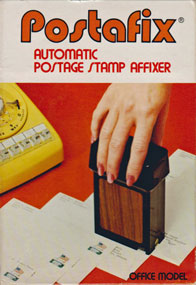
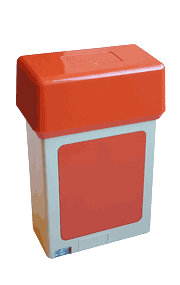
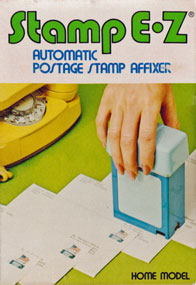
In the 1960s a new generation of plastic affixers came to market. The Data-Link Corporation filed patents from 1962 (US patent 3219511, US design patent D196529, and UK patent 1034414). In 1972 a patent was filed for an improved model in which substantially all parts were made of molded plastic (US patent 3793124). The company filed for trademarks for “Postafix” in 1965, “Postacount” in 1967, and “Stamp E-Z” in 1971. Postafix was the office model (using rolls of 100 or 500 stamps) and Stamp E-Z was the home model (rolls of 100 stamps only), but later models used both rolls. There were three colours: a rather uninteresting black with wood grain side panels; a tan base with tangerine top & side panels; and a dark blue base with light blue top & side panels.
The stamp affixer assets of Data-Link were acquired by Escalade Inc in July 1994, and continued to be sold by their Martin Yale Industries subsidiary.
| DL-03 | Stamp E-Z | Light & dark blue |
| DL-04 | Stamp E-Z | Tangerine & tan |
| DL-05 | Postafix | Black & wood grain |
| DL-06 | Postafix | Tangerine & tan |
| DL-10 | Postafix | Stamp affixer only |
| DL-15 | Postacount | Stamps and counts |
| DL-20 | Secretariat | Stamps, seals, opens |
| DL-25 | Secretariat | Stamps, seals, counts |
| DL30 | Stamp E-Z | Black & wood grain |
| DL31 | Stamp E-Z | Light & dark blue |
| DL32 | Stamp E-Z | Tangerine & tan |
| DL40 | Postafix | Black & wood grain |
| DL41 | Postafix | Light & dark blue |
| DL42 | Postafix | Tangerine & tan |
Martin Yale Industries later re-used the name DL32 for an affixer for self-adhesive stamp rolls.
In New Zealand, Postafix was sold from January 1969 to replace the ageing Lightning affixers. Initially “Lightning rolls” were sold for use in the Postafix but these rolls were replaced in the 1970s by “Postafix rolls”.

Desktop Affixers
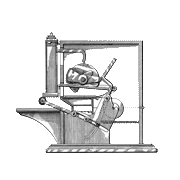
Elliot
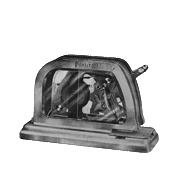
Postcraft
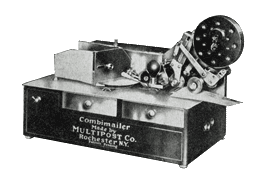
Multipost Combimailer
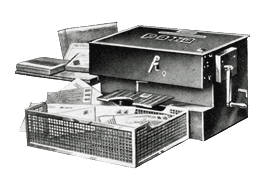
POKO
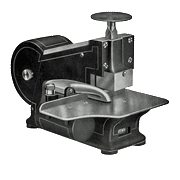
National
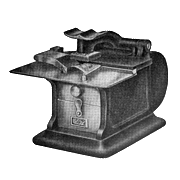
White
Elliot (Los Angeles, CA): a small square desktop affixer (about 10x7x6 inches) c.1908 made by the Elliot Company, founded by Charles Elliot (one t) of Croydon, England after coming to LA as a tea broker. This is not connected to the Elliott Envelope Sealer and Elliott Addressing Machine which were invented by Sterling Elliott (two t’s) around the same time. The image above is from patent 517740 as no photograph has been found.
Multipost (Rochester, NY): after success with handheld affixers, Multipost turned their attention to the competition of metered, permit, and pre-cancelled mail and c.1930 introduced the Combimailer. The machine could seal 200 envelopes per minute and optionally (higher prices models) could: affix a stamp; print a postmark; print a permit (US patent 1949158). Combimailer cancellations are known from 1932 to 1940 and are very collectable.
National (Boston, MA): c.1911, made by the National Envelope Sealing and Stamping Manufacturing Co, 200 Devonshire St, Boston. Also as the National Envelope Sealing and Stamping Machine Co — both companies, Manufacturing Co & Machine Co, were formed in 1910 and dissolved in 1914. Patents were filed by Fred R Allen of Providence, RI. The company made a desktop affixer using endways rolls (US patents 1071631, 1127843, 1124577) and a large floor standing machine using sideways rolls (see Floor Standing Affixers below). In 1914, the company moved and reorganized as the National Automatic Machine Co, Brattleboro, Vermont.
Postcraft (New York): c.1909, before making a handheld affixer (see above), the P R Manufacturing Company of Detroit, Michigan made a stamp vending machine (US patent 1071178), then c.1911 a combined vending and affixing machine (US patents 1076517 and 1274448). Although the title of the latter patent is “Stamp Vending and Affixing Machine”, the text does not mention coins or vending, and appears to describe a desktop affixer.
White (Providence, RI): c.1910, made by the Office Appliance Manufacturing Co at 56 South Water St, Providence, RI with a sales office in New York at 177 Broadway. The affixer used endways rolls and was patented by Samuel B White (US patents 968619, 1043554, 1124368).
POKO (Germany): c.1909 the POKO (short for Porto Kontroll Kasse) was a large desktop machine. Patents were filed in France 519018 and the UK 149255 by Deutsche Post und Eisenbahn Verkehrswesen (Deutsche Post and Railway Transportation). The factory in Germany was destroyed in WWII. In the UK, POKO used lower end delivery rolls: ½d(D), 1d(B), and later 1½d(K), 2d(Q), 2½d(F), 3d(C), 4d(A), and 6d(J). The open POKO shown below holds seven rolls, a lever on the side selects which roll to use, then a crank handle applies the stamp. Seven counters can be seen, one for each roll of stamps. The counters are visible through a window in the top when the machine is closed and locked:
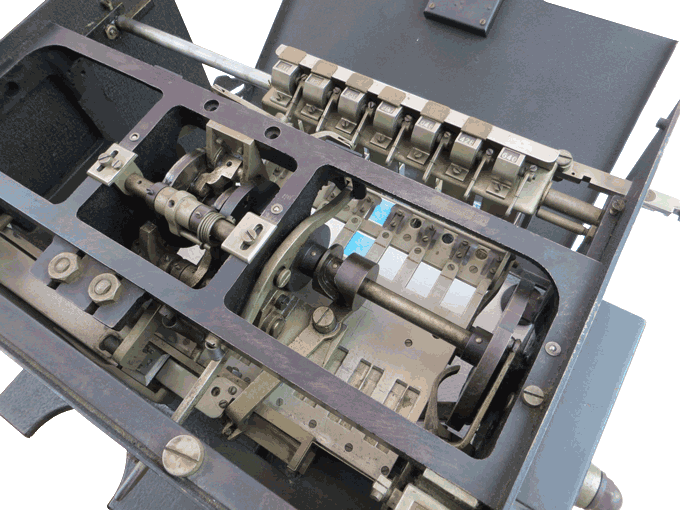
A 5-roll machine was marketed pre-war by British Electric Automatic Machines (BEAM) Ltd, Caxton House, Tothill St, London; and post-war, a 7-roll machine was marketed by H M Rose & Co, 65/66 Basinghall Street, EC2, and later c.1927 by Mail Room Equipment Ltd (a subsidiary of Block & Anderson Ltd). A 3-roll POKO Junior sold c.1930 for £30 (the 7-roll was £50, or £80 with an electric motor).
Click the brochures to enlarge.
Floor Standing Affixers
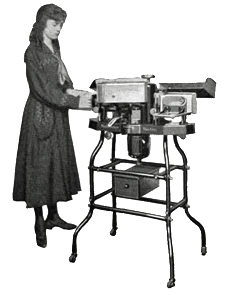
Schermack Mailometer
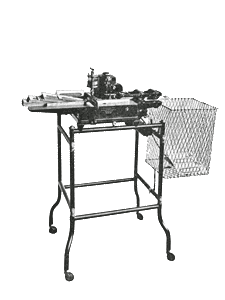
National
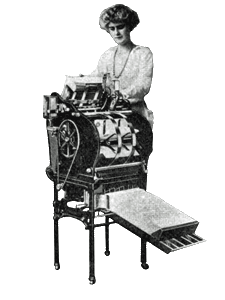
Pence
Schermack/Mailometer (Detroit, MI): c.1907, initially as the Detroit Mailing Machine Co at 346 Holden Ave, then in 1908 as the Schermack Mailing Machine Co, then in 1909 as the Mail-om-eter Co (c.1922 the spelling was changed to Mail-O-Meter). The machine used privately perforated sideways rolls with distinctive “Schermack Perforations”. Adverts claimed “seals, stamps, and counts 250 envelopes per minute” or “10,000 envelopes per hour”. Patents were filed by Joseph J Schermack in the US (961465, 1146902) and by Harris L Henry in the UK (4514/07). In 1924 the Pitney-Bowes Postage Meter Co bought the Mail-O-Meter Co. Manufacturing of the affixer was transferred to Stamford, Connecticut in 1925 and the machine continued to be sold as the “Model M O M”.
National (Boston, MA): c.1911, made by the National Envelope Sealing and Stamping Manufacturing Co, 200 Devonshire St, Boston. Also as the National Envelope Sealing and Stamping Machine Co — both companies, Manufacturing Co & Machine Co, were formed in 1910 and dissolved in 1914. Patents were filed by Fred R Allen of Providence, RI. The company made a desktop affixer using endways rolls (see Desktop Affixers above) and a large floor standing machine, similar to the Schermack, using sideways rolls (US patents 1110097, 1170949). In 1914, the company moved and reorganized as the National Automatic Machine Co, Brattleboro, Vermont.
Pence (Minneapolis, MN): c.1914, the third company to make a combined envelope-sealer/stamp-affixer, and perhaps the least successful. The machine used endways rolls, which were not well suited to fast operation. A patent was filed by Sidney L Long (US patent 1223499). The company’s assets were sold to the Bircher Company of Rochester, New York c.1920 (as with the Kendall handheld affixer).
Vacuumatic (Harwich, UK): in the UK, the Post Office commissioned an automatic affixer to be used at the Boy Scout Jamboree of 1957. Two machines were made by Vacuumatic Limited of Harwich, Essex, at a cost of £2,650. They could service 120 covers per minute with the set of three stamps. Covers in quantities of 60 or more were accepted up to 22 July with a charge of 2/- per cover, the face value of the stamps being 1/9½d. Ultimately only 60,632 covers were serviced, compared with initial estimates of a few million.
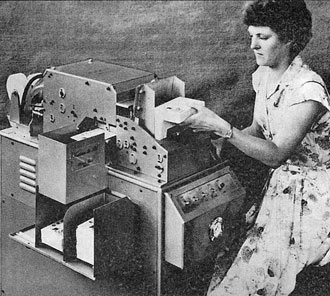
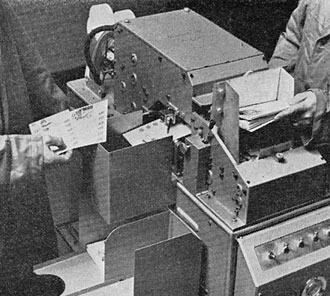
Later, McCorquodale used a Vacuumatic machine to uprate postal stationery after rate increases, although it seems they preferred to use manual labour as the machine, although faster, wasn’t “scalable”.
Vending Machines
The first patent for a stamp vending machine using rolls of stamps was filed by Constant F De Redon (citizen of France, residing in New York) on 16 July 1888 (US patent 397975). The specification leaves little doubt about the form of stamps used: The apparatus constituting the invention is especially designed for the automatic vending of postage-stamps, railway-tickets, accident insurance policies, and similar things which are or may be prepared and put up in the form of long strips and wound upon a reel or spool.
Unlike stamp affixers, which had more than 100 patents filed by 1906, stamp vending machines got off to a much slower start, with only 15 or so patents filed in the same period, presumably as the inventive ideas for vending machines focused on more profitable items than stamps. However, during 1906 authorities started to take stamp vending machines seriously, and trials took place by both US and UK Post Offices.
Of particular interest is the Dickie-Brown machine (Kermode machine). The simple, reliable design was successfully trialled with the UK Post Office and was selected by the US Post Office as the best of all those tested. A coin pushed into the slot at the top of the machine raises the driving weight (that large rectangular block of metal). If the coin passes the coin tester, then the weight is allowed to drive the feed wheel, and a stamp emerges from the slot. The “1c” plate on the Dickie-Brown machine below (above the coin slot) covers the word “PENNY”, which suggests this machine was still in use after New Zealand decimal currency day, 10 July 1967.
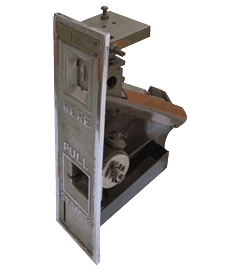
Dickie-Brown (NZ)
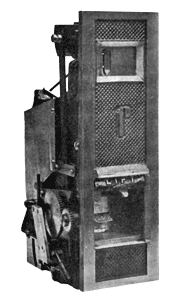
Type A (UK)
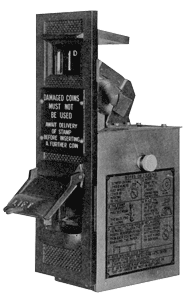
Type B4 (UK)
Click the diagrams to enlarge.
Patents were filed in several countries by Robert James Dickie (postal clerk) and John Henry Brown (photographer) both of Wellington, New Zealand. Patent 18548/04 was filed in New Zealand 1904-10-05, patent 178704 filed in Australia 1904-10-20, patent 94953 filed in Canada 1904-11-09, patent 25875/04 in the UK 1904-11-28, and patent 829514 in the US 1905-10-19. A later patent 884802 was filed 1907-02-06 by Dickie and Brown, and was assigned to the United States Automatic Vending Co.
Mrs Kermode formed the British Stamp and Ticket Automatic Delivery Co Ltd (BSTAD) in 1907 to market the Dickie-Brown machine. Although known to GB collectors as a Kermode machine, it’s known to the rest of the world as a Dickie or a Dickie-Brown machine, and was sold in New Zealand, Australia, Canada, US, and UK.
The first Kermode machines were installed in the UK in early 1907 at the House of Commons and Threadneedle Street branch offices. A dozen more were installed between July 1907 and April 1909. By 1911, there were 100 dual machines (½d & 1d) around the UK. The BSTAD contract expired in September 1920 and the Post Office took over the machines on their premises which then became the first Post Office owned and operated vending machines, later called Type A. In 1924, mechanical improvements lead to Type B. Type B4 remained in use for many years, some were converted to 3d with the Oct 1957 postal rate increase, some were converted to 1p after decimalisation in 1971. The value was selectable at time of manufacture, not in the field. Type B5 was introduced in 1947 to address dampness but the trial was not successful. For locations with a single machine, Type C vended two ½d stamps for a penny. Type C numbers ran in parallel with Type B, Type D numbers followed sequentially, with B5 followed by D6 (there was no B6 as incorrectly reported elsewhere).
| Type | Date | Stamps | Coins | Manufacturer |
|---|---|---|---|---|
| — | 1907 | ½d or 1d | ½d or 1d | BSTAD |
| A | 1921 | ½d or 2d | ½d or 2x1d | BSTAD |
| A1 | 1922 | ½d or 1d | ½d or 1d | BSTAD |
| B | 1924 | ½d or 1d | ½d or 1d | BSTAD |
| B1 | 1929 | ½d or 1d | ½d or 1d | HTA |
| B2 | 1930 | ½d or 1d | ½d or 1d | HTA |
| B3 | 1932 | ½d or 1d | ½d or 1d | Brecknell |
| B4 | 1935 | ½d,1d,3d or 1p | ½d,1d,3d or 1p | HTA |
| B5 | 1947 | ½d or 1d | ½d or 1d | HTA |
| C | 1926 | 2x½d | 1d | BSTAD |
| C1 | 1930 | 2x½d | 1d | HTA |
| C2 | 1930 | 2x½d | 1d | HTA |
| C3 | 1932 | 2x½d | 1d | Brecknell |
| C4 | 1935 | 2x½d | 1d | HTA |
| D6 | 1951 | 2d | 2x1d | HTA |
| D7 | 1965 | 2x2d | 1d+3d | AA* |
A new type of vending machine was developed in preparation for decimalisation. The machine needed to operate on a coin that would be the same size and weight before and after the changeover. The one shilling coin was chosen, hence the need to issue multiple stamps for one coin, initially a strip of five stamps totaling one shilling, then five stamps totaling five new pence after decimalisation.
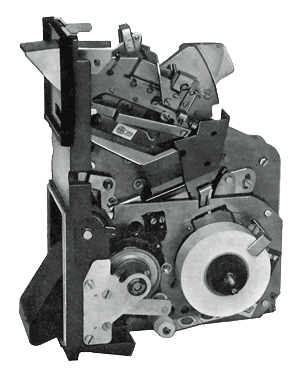
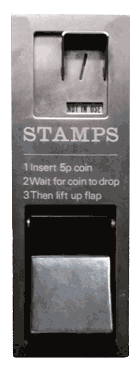
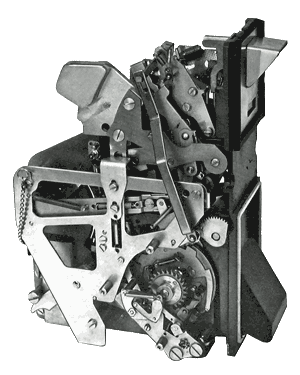
| Type | Date | Stamps | Coins | Manufacturer |
|---|---|---|---|---|
| G1 | 1969 | 2d,2d,3d,1d,4d | 1s | AA* |
| G2 | 1971 | 2p,½p,½p,1p,1p | 5p | AA* |
| G3 | 1975 | 6p,2p,1p,½p,½p | 10p | AA* |
* Hall Telephone Accessories became Associated Automation in 1956.
Counter Machines
Post Office counter machines were designed to speed up the sale of stamps over the counter.
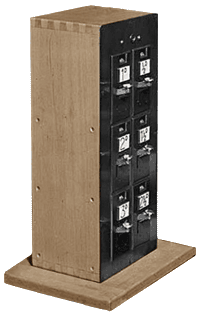
An experiment with a three-tier counter machine began at Mount Pleasant Branch Office in 1947. Each tier had two emitters enabling the machine to dispense six different stamp values: ½d to 3d. Only ½d and 1d stamps were available in rolls for vending machines at the time, so special experimental rolls were made up with 1½d to 3d stamps. These rolls were overprinted “EXP”, short for “experimental” and not to be confused with the 1952 (EXP) rolls which were for use in exposed places.
The then current (W) and (X) rolls were used for ½d and 1d (not (D) and (B) as Langston & Corless presumed), but as there were no higher values available wound for vending machines, special rolls were made up for 1½d, 2d, 2½d, and 3d values. Leaders were used from the POKO series of rolls (KQFC) but these were not POKO rolls, they were wound facing inwards rather than outwards, and on a smaller core, so the stock letters were obliterated to avoid confusion, and a large “EXP” stamped on each leader. For more detail on these rolls, click here.
The experiment ran at Mount Pleasant for about 5 years from 20 Jan 1947 to Feb/Mar 1952. At least two other offices used these machines: Romford Post Office from 12 Aug 1947 to 20 Mar 1948, and Southall Head Post Office from 13 June 1948. The latter sold 1d, 2d, 2½d, 3d, 6d, and 9d stamps.
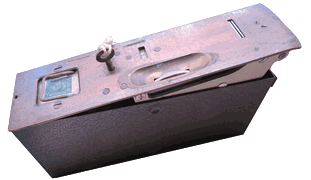
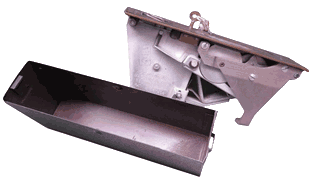
The Post Office found that 65% of sales were for 2½d letter rate stamps. Hence, a single emitter machine was developed with Hall Telephone Accessories (shown above) and put into use at Battersea Rise Post Office, Northcote Road on 21 Nov 1949. A new roll of 1,920 2½d stamps, stock letter (U), was issued specifically for this machine. The abstract from UK patent 637406 describes how the machine was used: In a machine for issuing stamps, tickets, etc, from a strip magazine, delivery is commenced by means of a finger feed-wheel, and when a portion of the strip has been thus issued from the orifice, the strip may be pulled by hand until the desired quantity has been obtained, the number of stamps issued being recorded on a counter coupled to the delivery means.
A short article in Gibbons Stamp Monthly (March 1954, page 75) describes a third type of counter machine, but nothing seems to have come of this trial:
New Stamp-Delivering Machine
Recent letters to the press criticizing the Post Office’s insanitary methods of selling stamps, which are usually torn off by hand and pushed across a dubious counter, will find their answer in the “Stampmaster” machine now on trial at a Washington post office.
In appearance it is similar to the flush counter-machine used by cinemas here for delivering tickets except that it is operated by telephone dials instead of push buttons. The clerk dials the number of stamps requested and out they come in a strip in front of the customer for him to tear off. Six of the most called-for denominations are available.
